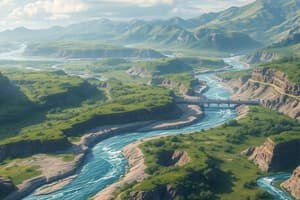Podcast
Questions and Answers
What is the lower course?
What is the lower course?
The lowest part of the river. It has a low energy level and the process of deposition takes place. The lower course is now deep and wide and the land area around is flat. The lower course contains the delta/mouth of the river.
The lower course contains waterfalls.
The lower course contains waterfalls.
False (B)
How do levees form?
How do levees form?
Levees form when the flow of the river is slow and sediment is too heavy for the river to carry further, thus being deposited. They are formed at times of floods where a lot of sediment is deposited.
At the lower course the river is now _____ and _____ and the landscape around is ____.
At the lower course the river is now _____ and _____ and the landscape around is ____.
What are the uses of levees at times of a flash flood?
What are the uses of levees at times of a flash flood?
Where does the river end?
Where does the river end?
In the lower course the river has a _____ volume and _____ discharge.
In the lower course the river has a _____ volume and _____ discharge.
Which course of the river does deposition mostly happen?
Which course of the river does deposition mostly happen?
What kind of erosion happens in the lower course?
What kind of erosion happens in the lower course?
In the middle course, the river has _____ energy and a ____ volume of water.
In the middle course, the river has _____ energy and a ____ volume of water.
The main transportation is _____, so the water is _____.
The main transportation is _____, so the water is _____.
What processes and forces cause a meander to form?
What processes and forces cause a meander to form?
On the inside of the bend in a meander, the river flow is slower.
On the inside of the bend in a meander, the river flow is slower.
Why do rivers have meanders?
Why do rivers have meanders?
Where is the current the fastest in a meander?
Where is the current the fastest in a meander?
Where do rivers begin?
Where do rivers begin?
Speed of the river flow _________ because the gradient is the steepest.
Speed of the river flow _________ because the gradient is the steepest.
What are the features of the upper course?
What are the features of the upper course?
Where are waterfalls located?
Where are waterfalls located?
Is there a high amount of sediment in the upper course?
Is there a high amount of sediment in the upper course?
The amount of sediment in the upper course is the greatest among the three courses.
The amount of sediment in the upper course is the greatest among the three courses.
The upper course is the fastest course in the river.
The upper course is the fastest course in the river.
Which course has the smallest volume of water?
Which course has the smallest volume of water?
What features are in the upper course?
What features are in the upper course?
Water is fast moving and turbid in the upper course.
Water is fast moving and turbid in the upper course.
What type of erosion happens in the upper course?
What type of erosion happens in the upper course?
Does deposition of sediment often occur in the upper course?
Does deposition of sediment often occur in the upper course?
Flashcards are hidden until you start studying
Study Notes
Lower Course Characteristics
- The lower course is the river's lowest part, characterized by low energy levels and deposition processes.
- The landscape in the lower course is deep, wide, and flat.
- The river flows into a delta or mouth at its end.
- Levees form from the slow movement of the river, depositing heavy sediment during floods.
- In times of flash floods, levees act as natural barriers to prevent water overflow to surrounding areas.
- The lower course has a high volume of water and large discharge.
- Deposition is primarily concentrated in the lower course.
- Lateral or horizontal erosion predominates in this section.
Middle Course Characteristics
- The middle course features more energy compared to the upper course, along with a high volume of water.
- Sediment is mainly transported in suspension, leading to murkier waters.
- Meanders form due to erosion and deposition, influenced by gravity and centrifugal force.
- The river flows slower on the inside of a meander bend.
- The fastest current occurs on the outside bend of a meander due to reduced friction.
Upper Course Characteristics
- The upper course begins in upland areas and flows downhill, deepening and widening as it approaches the sea.
- The speed of the river flow is greatest in this section due to steep gradients.
- Key features of the upper course include V-shaped valleys, interlocking spurs, and waterfalls.
- Waterfalls are prominently found in this upper section.
- The upper course has the smallest volume of water compared to the other river courses.
- Fast-moving and turbid water indicates high erosion potential in the upper course, primarily through vertical erosion.
- Deposition of sediment can occur, though it is less frequent due to higher energy levels.
Studying That Suits You
Use AI to generate personalized quizzes and flashcards to suit your learning preferences.




